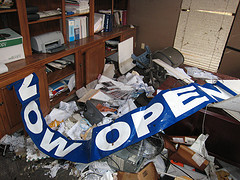What Are America’s Most Damaged Brands Right Now?
How mighty brands fall. Bad leadership, bad planning, a run of bad products: any of these can damage a brand in a short amount of time, and it can take years to recover: if, indeed, the brand recovers at all. What brands are the most battered in the United States right now? 24/7 Wall Street rounded them up, based on which publicly-traded major companies are currently dealing with aggressive competition, reputation disasters, and a lack of direction.
You can get more analysis over on their site, but here’s our take.
Martha Stewart the person had a successful comeback after her 2004-05 federal imprisonment for insider trading, but Martha Stewart the company hasn’t been doing so well in the last few years. The most damage to Martha’s brand has been the ongoing feud between JCPenney and Macy’s over the right to sell her branded housewares.
24/7 Wall Street notes that Apple hasn’t been innovating much recently, and that many experts and consumers consider the Samsung Galaxy S3 and upcoming S4 to be superior to the iPhone. When Apple replaced Google’s Maps application with their own terrible one on new phones, they got a PR disaster and handed lazy writers a tired metaphor for a company that has lost its way. Which I just used. Crap.
Hyundai’s 10 year/100,000 warranty gave Americans confidence in Korean cars. Hyundai and Kia had a reputation for quality, affordable cars. Then the Environmental Protection Agency pointed out that both companies had provided consumers with inaccurate fuel economy estimates, and consumers lost some of that hard-won confidence.
The Dreamliner 787 passenger jet has been delayed for years, and now everyone’s scared. Carriers own 787s that the Federal Aviation Administration has still grounded, passengers remain skeptical of the new model because it seems unsafe and scary, and Boeing is (probably) scared that its reputation will never recover.
5. J.C. Penney .. Or is it JCPenney?
The retailer is still struggling for relevance, and is now working on a turnaround of its initial turnaround under the brief tenure of CEO Ron Johnson. Even the free publicity they got from offending some conservative Americans couldn’t help. The chain has been chasing away its loyal customers without attracting new ones. First, they’ll need more competent employees.
Regular Consumerist readers are familiar with Best Buy’s continuing struggle for relevance. Turnaround CEO Brian Dunn abruptly left the company due to an inappropriate romantic relationship at work, but the stores were already functioning as just Newegg showrooms long before that. In an interview with Consumerist, a company executive expressed hope, pointing out that Best Buy’s multichannel online and retail footprint along with its shrinking army of blue shirts can help it make the transition, but they won’t need all of those massive superstores. Even its own founder decided against a plan to buy the company back.
Not so long ago, everyone loved Groupon. People loved it so much that it expanded quickly worldwide, and so many imitators popped up that customers and businesses alike became confused and over-couponed. The furious growth slowed, and Groupon was left with accounting problems and a lot of pissed-off small merchants.
8. Blackberry/Research in Motion
Does your company still issue BlackBerry smartphones? Neither does anyone else’s. The Z10 looks promising, but it may be too late.
Sure, it might be run by the Consumerist’s 2013 Sexiest CEO in America, Jamie Dimon, but that’s not enough to get a company through accusations of poor risk management after losing billions of dollars in only a few weeks. Customers aren’t much more fond of Chase than financial regulators are right now.
America’s Nine Most Damaged Brands [24/7 Wall Street]
Want more consumer news? Visit our parent organization, Consumer Reports, for the latest on scams, recalls, and other consumer issues.


